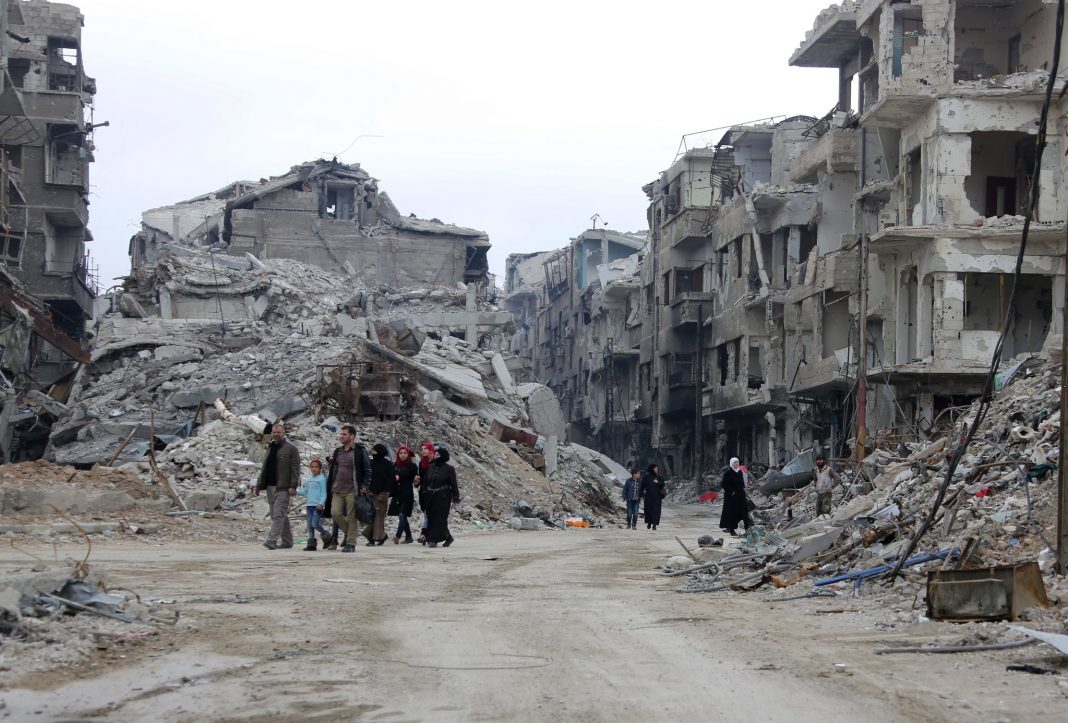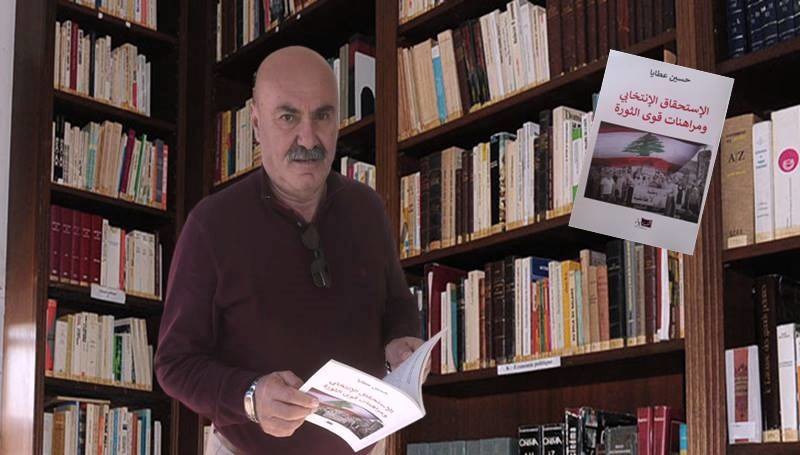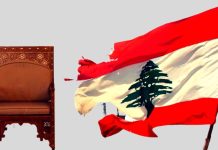Horrific Details on Syria Chemical Attacks Left Out, for Now, From U.N. Report
تفاصيل مرعبة عن استعمال النظام السوري للأسلحة الكيماوية التي لم ترد في تقرير الأمم المتحدة
By Rick Gladstone and Maggie Haberman/ The New York Times/June 20/18
At least twice this year, the Syrian military fired Iranian-made artillery shells filled with a chlorine-like substance that oozed poison slowly, giving victims just a few minutes to escape.
In another attack, Syrian forces dropped a chemical bomb on the top-floor balcony of an apartment building, killing 49 people, including 11 children. Their skin turned blue.
These details and others blaming Syria for atrocities in eastern Ghouta, a suburb of Damascus, were uncovered by a United Nations commission investigating and documenting possible war crimes in the seven-year-old conflict. But when the commission issued a report on Wednesday, the details were omitted.
Seven pages that had been in an earlier draft, provided to The New York Times, were summarized in two paragraphs in the final document.
The commission’s report examined how the government of President Bashar al-Assad recaptured eastern Ghouta, the rebel stronghold near the capital, in the first four months of 2018. Mr. Assad’s forces laid siege to the area, using bombardments, mass starvation and chemical weapons.
The materials in the leaked draft paint a far more frightening picture of chemical weapons use in eastern Ghouta than had been previously reported. And they assert without qualification that Syrian forces and their allies were responsible, rebutting repeated denials by Mr. Assad’s government and his backers in Russia and Iran.
A member of the commission explained the omissions, saying that many of the details in the early draft needed additional corroboration or clarification and might be included in another report, perhaps by September. There was no outside pressure to withhold the information, said the member, Hanny Megally, an Egyptian human rights lawyer.
“We thought we need to do some more work on this, it’s an ongoing investigation,” Mr. Megally said. “So we thought, let’s keep it short.”
But the conclusions in the omitted information seemed unambiguous.
The leaked draft stated: “In one of the most grim patterns of attack documented during the period under review, Government forces and/or affiliated militias continued to use chemical weapons in densely populated civilian areas throughout eastern Ghouta.”
In meticulous detail, the draft enumerated six chemical weapons assaults on civilians from January through April 7, the date of the deadliest assault. In what appeared to be a first, it implicated Iranian-supplied weaponry.
In attacks on Jan. 13, Jan. 22 and Feb. 1, the draft said, government forces fired chemical agents, “most probably chlorine,” into a residential part of eastern Ghouta’s Douma neighborhood, near a sports stadium, roughly 800 yards from the front lines, between 5 a.m. and 6:30 a.m.
Some witnesses described a “slow-acting agent” that smelled like chlorine, the draft said, and they had sufficient time “to rouse the victims, obtain wet cloths to serve as makeshift face masks, and evacuate the affected areas.”
In the Jan. 22 and Feb. 1 attacks, the draft said, the commission had evidence identifying the bomb delivery devices as surface-to-surface industrially produced Iranian artillery rockets, “only known to have been used by Government forces and, rarely, affiliated militias.”
“In relation to the munitions used on 22 January and 1 February, the Commission obtained and assessed material evidence including metadata analysis, and identified a surface-to-surface craft-produced rocket (IRAM). While IRAMs have been employed by a range of actors across Syria, the particular design of observed during these two attacks is only known to have been used by Government forces and rarely, affiliated militias. Specifically, IRAMs documented were built around industrially-produced Iranian artillery rockets known to have been supplied to Syrian Government forces.”
The draft said that the eastern Ghouta attacks had followed “a pattern previously documented by the Commission concerning the use of chemical weapons by Government forces,” and that none of them had suggested “the involvement of armed groups.”
Thirty-one people, including 11 children, were sickened in the first three attacks, but none died. Two other episodes of possible chlorine use, on Feb. 25 and March 7, caused more extensive casualties, killing two children, including an infant, and injuring 18 civilians.
The worst was yet to come, following the collapse of negotiations between Russian military officials and an insurgent group, Jaish al-Islam, to evacuate the Douma neighborhood and end the siege. On April 7, the draft said, an improvised explosive delivered from the air hit a multistory residential building roughly 200 yards from the Rif Damascus Hospital, the last functioning hospital in Douma.
The draft described the explosive as a “single industrial gas cylinder” with fins that struck the top-floor balcony and appeared to have “rapidly released large amounts of a substance into the interior space of the residential apartment building.”
“Positions and physical symptoms displayed by victims of the attack support witness claims that the agent acted rapidly,” the draft stated, “and likely indicate that a high concentration of the chemical sank downwards.”
Based on witness statements and “material evidence received and analyzed by the Commission,” the draft stated, the dead showed “an array of symptoms consistent with exposure to a choking agent, including signs of foaming at the mouth and nose, blue skin indicating impaired blood circulation, meiosis (constriction of the pupils), as well as some cases of dilated (wide open) pupils.”
“Statements and material evidence received and analysed by the Commission in relation to the deceased within the apartment building revealed an array of symptoms consistent with exposure to a choking agent, including signs of foaming at the mouth and nose, blue skin indicating impaired blood circulation, meiosis (constriction of the pupils), as well as some cases of dilated (wide open) pupils. Numerous victims unable to flee the building collapsed shortly after exposure.”
Mr. Megally declined to go into detail over why such information was withheld from the report published on Wednesday. But he said that with the April 7 attack in particular, more information was needed, including precisely what killed the 49 people.
“If we’re not sure what the cause of death was, we may be looking in the wrong place,” he said. “It’s better we finish the investigation, rather than release it in dribs and drabs.”
The official version of the report was far more cautious about the chemical weapons incidents in question. In two attacks, for example, the report said the commission was “unable to obtain sufficient material evidence to conclusively identify the weapons delivery systems.”
While the circumstances in the April 7 attack were “largely consistent with the use of chlorine,” it said, the symptoms were more consistent with the use of “another chemical agent, most likely a nerve gas.”
The official version also condemned rebel forces for indiscriminate shelling of civilian areas.
The commission, which has been compiling evidence of atrocities in the Syria conflict since shortly after the war began in 2011, has developed an extensive array of ways to gather information, even though Mr. Assad has not allowed its investigators into the country. Led by Paulo Sérgio Pinheiro, a Brazilian diplomat and rights activist, the commission has even compiled a confidential list of Syrian officials and others who may be held accountable in a court some day.
The earlier draft of its report on eastern Ghouta was shared by a person close to the commission, who had been consulted on the report and who declined to be identified.
The leak suggested some internal dissension in the commission about the strength of its evidence concerning the Syrian government’s use of chemical weapons in eastern Ghouta. It was also possible that the commission wanted to exercise caution ahead of an expected report on the April 7 attack in Douma by the Organization for the Prohibition of Chemical Weapons, which sent investigators to the site.
Chemical weapons are banned by an international treaty that Mr. Assad signed under pressure in 2013, when his government was first accused of having used chemical weapons in the conflict — also in eastern Ghouta.
The April 7 attack in Douma caused widespread international fury, particularly because many victims appeared to have been children shown gagging and choking, based on videos disseminated by witnesses and activists. The attack drew retaliatory missile attacks and airstrikes by Britain, France and the United States.
Mr. Assad’s government, backed by Russia and Iran, sought to cast doubt about the Douma attack, suggesting it had been faked or carried out by insurgents.
The Syrian government and its allies took control of eastern Ghouta two months ago after imposing what the commission’s report described as “the longest siege in modern history,” displacing more than 140,000 people from their homes and unleashing bombardments that destroyed hospitals, markets and schools, and forced residents to live in cellars and basements.
Those bombardments — mainly airstrikes by Syrian and Russian planes — killed 1,100 civilians and injured 4,000 others in a period of less than a month from Feb. 18, the commission said in its report, which is to be delivered to the United Nations Human Rights Council next week.
Tens of thousands of those who fled are still being held unlawfully by the government, which pursued a policy of blanket internment that the panel called “reprehensible.”
Sieges are permitted under international humanitarian law. But, in a departure from established practice, the panel said it considered the way pro-government forces had conducted the siege of eastern Ghouta unlawful.
“Certain acts perpetrated by pro-government forces during the siege laid to eastern Ghouta, including the deliberate starvation of the civilian population as a method of warfare, amount to the crime against humanity of inhumane acts, causing serious mental and physical suffering,” the panel concluded.
A version of this article appears in print on June 21, 2018 of the New York edition with the headline: U.N. Report Left Out Horrific Details on Syria Chemical Attacks.
https://www.nytimes.com/2018/06/20/world/middleeast/un-syria-eastern-ghouta.html





















